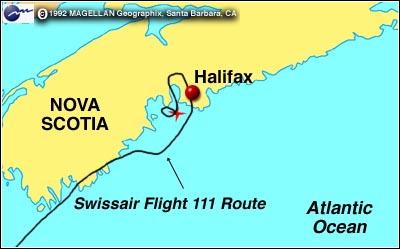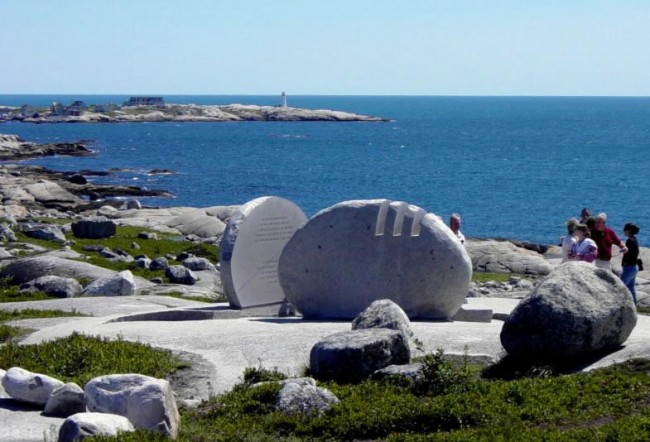I had never heard of Swiss Air Flight 111 or at least I didn't remember it. But while staying here we heard of 2 seperate memorials for this tragedy. It wasn’t until I started to research that I fully realized the sadness of the whole story. I was saddened for all these lives – famous United Nations officials, diplomats, students, couples heading to vacations, the pilots’ families back home, daughters, fathers, lovers. Some of the families of the victims return every year to this place, while others have even bought property here to be even closer to their loved ones. While only 3 victims were actually from Canada (nearly half were Americans, then Swiss and French), the residents of Nova Scotia and Peggy’s Cove instantly mobilized to pitch in and have been here to welcome the victim’s families still to this day…
 |
| Click on photo to read |
History from the internet:
On September 2, 1998, the MD-11 flight, which was on its way from New York City to Geneva, Switzerland, crashed into the Atlantic Ocean right here killing all 229 crew and passengers on board. The flight crew had detected smoke coming into the cockpit and had requested a non-emergency landing in Boston. Air Traffic Control offered up Halifax airport, which was even closer. In the next several minutes, the crew proceeded to go through their ‘unknown smoke checklist’ (they had yet to ‘see’ any fire) and after heading toward Halifax Airport, they circled back to the Atlantic to dump fuel. From some reports of burned and melted parts, it appears that fire eventually affected the cockpit which caused the auto-pilot and other controls to shut down. Later reports showed that electrical arcing—a discharge of electricity from a damaged cable—from the wiring for the in-flight entertainment system, triggered the fire which spread rapidly in the plane’s insulation materials, while no one on board new of its severity. To investigators’ surprise, the aircraft’s thermal insulation blankets, which had passed an FAA test for fire safety, readily ignited in a test conducted during the largest transport investigation in Canadian history.

Just 10 minutes after the initial call, matters grew rapidly worse. It is said that the spreading fire led to the failure of key displays and systems making the crew unable to control the aircraft. Because it was pitch black out and he had no light to see the controls after the displays failed, the pilot was forced to steer the plane blindly. Both pilots now radioed a true ‘emergency declaration’. The Swiss Air flight began descending rapidly and once more declared an emergency. Just seconds later controllers lost all communication with the plane. The first officer continued to try to fly the crippled plane possibly in immense heat. He shut down the second engine approximately one minute before impact, implying he was still alive and at the controls until the aircraft struck the ocean, just about 17 minutes after their initial urgent (but not emergency) call. The plane hit the ocean going a speed of about 350 mph, at a 20 degree nosedive, and at a bank turn angle of 110 degrees (think of 90 degrees as perpendicular to the ocean). The aircraft disintegrated into millions of pieces on impact, killing all on board instantly. A search and rescue operation was launched immediately by the Canadian Coast Guard, the Canadian Forces Air Command, the Maritime Command and the Land Force Command. Dozens of nearby fishing boats and coast guard ships hurried to the crash site, about six miles off the coast of Peggy’s Cove. Because of the impact, only one single passenger was able to be identified visually, the rest were identified by fingerprints, dental records, and DNA and the operation quickly became one of search and recovery. Eventually 98% of the plane was recovered, including 150 miles of wire, and painstakingly sorted, labeled, pieced back together, and used to rebuild the front of the plane inside a hangar in Halifax. The meticulous investigation went on for four years at the cost of approximately $39 million dollars.
 |
| Swiss Air Flight 111 Memorial at Peggy's Cove |
 |
| Swiss Air Flight 111 Memorial near Peggy's Cove |
The cockpit voice recorder and flight data recorder were found by a submarine using sonar. However, both had stopped recording when the aircraft lost electrical power at approximately 10,000 ft, 5 minutes before impact. The crash is generally believed to have been caused by faulty wiring, after the entertainment system in the plane started to overheat.
Airline safety expert David Evans said in an interview with PBS’s Nova, “the legacy of this case is enormous, because we have a continuing problem with in-flight smoke and fire. I like to say that if the cabin of a modern jetliner was a restaurant, it would not get an occupancy permit, because you’ve got people in a confined space with no fire detection or suppression, and they’re sitting on top of high-powered electrical circuitry and a big load of fuel. You have all this in very close proximity.”
 |
| Swiss Air Flight 111 Memorial at Baywater |
I have to admit, as we stood at the shore on this beautiful sunny day in Nova Scotia it was sad that it held this tragedy. So sad ~ it broke my heart. The only fortunate bit of news in all of this was that the plane did crash into the sea and not on land in Nova Scotia perhaps killing even more. Also, the sea water was advantageous in instantly stopping the fire and leaving the debris exactly in the state it was just before impact. Such a sad story but is a BIG part of the South Shore in Nova Scotia.
Have Fun & Travel Safe

 Soon we were back on the road and headed towards the town of Baddeck... Baddeck is considered to be the beginning and end of the world famous “Cabot Trail” and is situated in the heart of Cape Breton Island. Stretching along the shores of the beautiful Bras d'Or Lakes, it is a village in full bloom with a kaleidoscope of colors displayed in baskets, boxes and gardens along its downtown shopping core. Finally we were all hungry and decided to go to lunch at a cute little restaurant called The Yellow Cello
Soon we were back on the road and headed towards the town of Baddeck... Baddeck is considered to be the beginning and end of the world famous “Cabot Trail” and is situated in the heart of Cape Breton Island. Stretching along the shores of the beautiful Bras d'Or Lakes, it is a village in full bloom with a kaleidoscope of colors displayed in baskets, boxes and gardens along its downtown shopping core. Finally we were all hungry and decided to go to lunch at a cute little restaurant called The Yellow Cello





















































